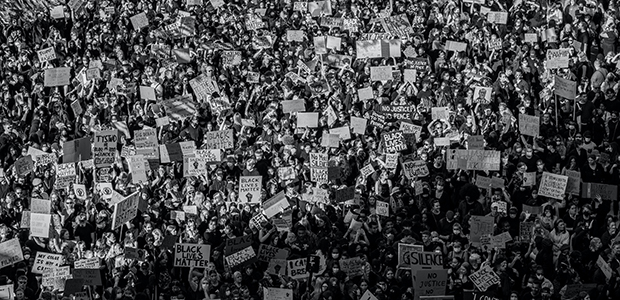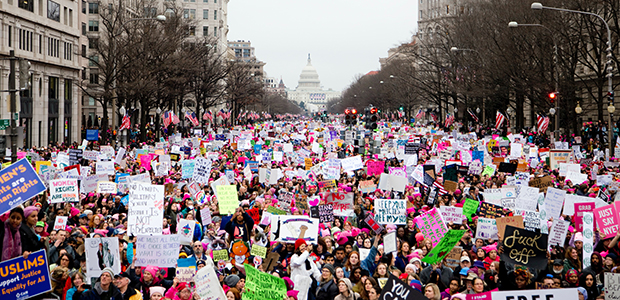Blog
A world of protest
That we are living in an era of popular protest is undeniable. A quick survey of headlines from around the world — or better yet, your social media feed — reveals countless uprisings unfolding in real time. Farmers protest efforts to privatize their land in India, Argentinians march to provide women reproductive justice, citizens rise up against police brutality in Nigeria and the United States. The list goes on.
Empirical evidence bears out the anecdotal. According to a report by the Center for Strategic and International Studies, globally ‘mass protests increased annually by an average of 11.5 percent from 2009 to 2019.’ The COVID-19 pandemic has done little to slow this trend. The scale of these protests is truly historical. Black Lives Matter protests in the US were the largest ever in that country. India’s farmer protests may be the largest mass uprising the world has ever witnessed.
What drives people to sacrifice their time and resources, not to mention risk their lives, by participating in popular uprisings? While the issues which motivate protest are diverse, there are several patterns that deserve attention. First, many protests reveal frustration with existing political systems, regardless if these are classified as democratic or authoritarian. Sustained popular movements are more often associated with democratic regimes, as they are more likely to be tolerated by the legal regime. But, even in authoritarian contexts, we observe an increase in sustained popular action.

Both established democracies and autocracies experience protest
The conventional narrative frames protest as resulting from ‘democratic backsliding’ — when established democracies roll back freedoms. This suggests that the only reason people protest is because countries are becoming more authoritarian. A more nuanced perspective might ask, instead, what democracies and autocracies share that causes protest.
For starters, even established democracies have limited outlets for civic participation, with membership in established parties and participating in elections often being the only sanctioned options. In many places, citizens are wary of political parties and elections. Electoral systems across the world are criticized for enshrining a narrow set of policy options and favouring established political parties. They don’t always allow everyone the same access to the political system.
Next, the age gap between rulers and the governed has increased globally. African countries have, on average, a 40-year age gap between their rulers and their overwhelmingly young populations. This generational divide reveals itself in major differences over key policy debates, such as climate change and inequality, where young people favour far more urgent and radical solutions than those championed by existing political parties.

Precarity and inequality motivate protest
Economic issues reveal another set of commonalities between democracies and autocracies. While historically protest was associated with the lower classes, protest is not merely driven by poverty. Instead, many of today’s protest movements are motivated more by economic inequality, even where the overall pie may be getting larger.
Across the world, the share of wealth held by the top 10% — and especially the top 1% and 0.1% — has only grown. This is true even where countries have experienced sustained economic growth, such as in many parts of Africa, Latin America, and Asia. Thus, both economic inequality and precariousness appear more likely to motivate popular uprisings than overall levels of poverty. This too is related to the growing disillusionment with existing political systems that largely seem incapable or unwilling to address growing wealth disparities.
Technology has changed protest movements for better and worse
One major debate that has shadowed the rise of protests globally is what role technology — in particular, social media — has played. Early on, the protests in Iran and the ‘Arab Spring’ were seen as the result of Facebook and Twitter, heralding a new era for popular democracy. Over time, however, the discourse around social media’s emancipatory potential has curdled.
Most analysts now understand technology’s role as offering both a boon and a curse. While social media can help activists gain attention and resolve challenging coordination problems, it also benefits governments, too, by providing them easy tools to monitor and manipulate public opinion and to surveil individual activists.
No justice, no peace?
This era of global protests evokes memories of earlier waves, such as the successful anti-colonial protests of the 1940s and 1950s, the anti-communist uprisings of the 1980s and 90s, and the less successful ‘colour revolutions’ of the 1990s and 2000s. During these earlier waves, protests stretched on for decades, bouncing between countries and regions, and signaling a sustained disillusionment with the prevailing political and economic systems.
Similarly, today’s wave of protests suggests a common frustration and disillusionment with both national governments and the broader global order. Despite the best efforts of governments around the world, protests are not going away. Instead, they demand a reconsideration of the economic and political conditions that drive so many to hit the streets in the first place.
Zachariah Mampilly is the Marxe Endowed Chair of International Affairs at the City University of New York
The views expressed in this piece are those of the author(s), and do not necessarily reflect the views of the Institute or the United Nations University, nor the programme/project donors.
 Join the network
Join the network




